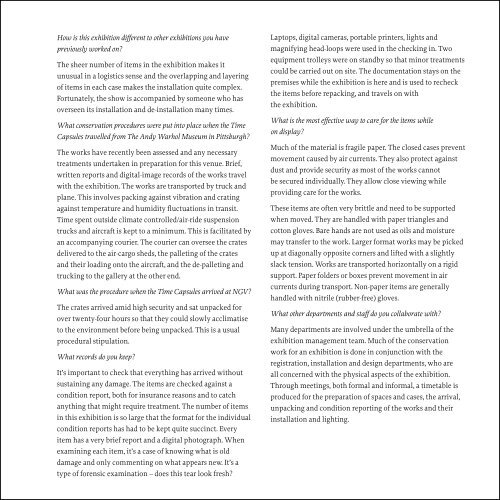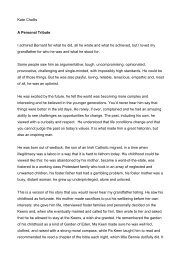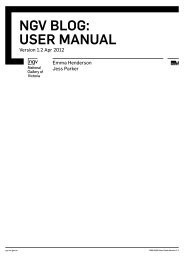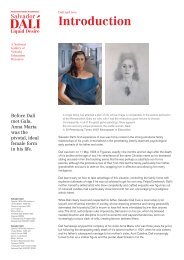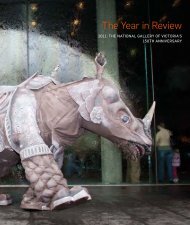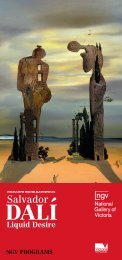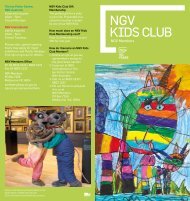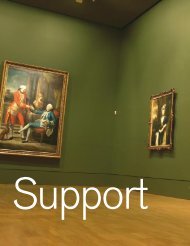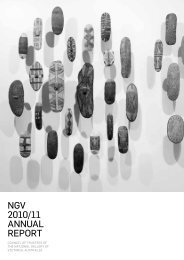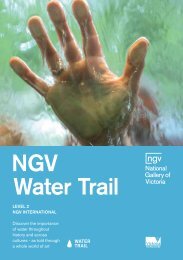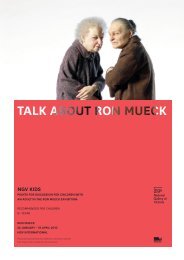Andy Warhol's Time Capsules (416.9 KB PDF) - National Gallery of ...
Andy Warhol's Time Capsules (416.9 KB PDF) - National Gallery of ...
Andy Warhol's Time Capsules (416.9 KB PDF) - National Gallery of ...
You also want an ePaper? Increase the reach of your titles
YUMPU automatically turns print PDFs into web optimized ePapers that Google loves.
How is this exhibition different to other exhibitions you havepreviously worked on?The sheer number <strong>of</strong> items in the exhibition makes itunusual in a logistics sense and the overlapping and layering<strong>of</strong> items in each case makes the installation quite complex.Fortunately, the show is accompanied by someone who hasoverseen its installation and de-installation many times.What conservation procedures were put into place when the <strong>Time</strong><strong>Capsules</strong> travelled from The <strong>Andy</strong> Warhol Museum in Pittsburgh?The works have recently been assessed and any necessarytreatments undertaken in preparation for this venue. Brief,written reports and digital-image records <strong>of</strong> the works travelwith the exhibition. The works are transported by truck andplane. This involves packing against vibration and cratingagainst temperature and humidity fluctuations in transit.<strong>Time</strong> spent outside climate controlled/air-ride suspensiontrucks and aircraft is kept to a minimum. This is facilitated byan accompanying courier. The courier can oversee the cratesdelivered to the air-cargo sheds, the palleting <strong>of</strong> the cratesand their loading onto the aircraft, and the de-palleting andtrucking to the gallery at the other end.What was the procedure when the <strong>Time</strong> <strong>Capsules</strong> arrived at NGV?The crates arrived amid high security and sat unpacked forover twenty-four hours so that they could slowly acclimatiseto the environment before being unpacked. This is a usualprocedural stipulation.What records do you keep?It’s important to check that everything has arrived withoutsustaining any damage. The items are checked against acondition report, both for insurance reasons and to catchanything that might require treatment. The number <strong>of</strong> itemsin this exhibition is so large that the format for the individualcondition reports has had to be kept quite succinct. Everyitem has a very brief report and a digital photograph. Whenexamining each item, it’s a case <strong>of</strong> knowing what is olddamage and only commenting on what appears new. It’s atype <strong>of</strong> forensic examination – does this tear look fresh?Laptops, digital cameras, portable printers, lights andmagnifying head-loops were used in the checking in. Twoequipment trolleys were on standby so that minor treatmentscould be carried out on site. The documentation stays on thepremises while the exhibition is here and is used to recheckthe items before repacking, and travels on withthe exhibition.What is the most effective way to care for the items whileon display?Much <strong>of</strong> the material is fragile paper. The closed cases preventmovement caused by air currents. They also protect againstdust and provide security as most <strong>of</strong> the works cannotbe secured individually. They allow close viewing whileproviding care for the works.These items are <strong>of</strong>ten very brittle and need to be supportedwhen moved. They are handled with paper triangles andcotton gloves. Bare hands are not used as oils and moisturemay transfer to the work. Larger format works may be pickedup at diagonally opposite corners and lifted with a slightlyslack tension. Works are transported horizontally on a rigidsupport. Paper folders or boxes prevent movement in aircurrents during transport. Non-paper items are generallyhandled with nitrile (rubber-free) gloves.What other departments and staff do you collaborate with?Many departments are involved under the umbrella <strong>of</strong> theexhibition management team. Much <strong>of</strong> the conservationwork for an exhibition is done in conjunction with theregistration, installation and design departments, who areall concerned with the physical aspects <strong>of</strong> the exhibition.Through meetings, both formal and informal, a timetable isproduced for the preparation <strong>of</strong> spaces and cases, the arrival,unpacking and condition reporting <strong>of</strong> the works and theirinstallation and lighting.


